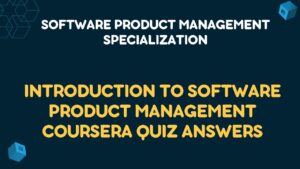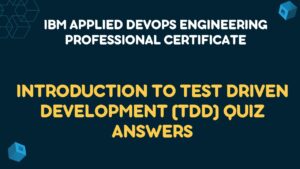Table of Contents
Version Control with Git Coursera Quiz Answers
Module 1 Assessment
Q1. Which one of these statements about Git is true?
- Git helps manage the history of the project.
Q2. Which one of these statements about branches is true?
- The default branch is named “master”.
Q3. What is a request to merge your branch into another branch called?
- Pull request
Q4. If a remote repository is offline, which one of the following is true?
- You can continue to work with the local repository.
Q5. Which one of the following is true?
- Git implements distributed version control.
Q6. Which one of these statements about commits is true?
- A commit is a snapshot of the project.
Q7. Which location contains the list of files that will be included in the next commit?
- Staging area
Q8. Which location contains the commit history of a project?
- Remote repository
Q9. When a file is first placed in the working tree, what is its status?
- Untracked
Q 10. What must you do to add a new file to the next commit?
- Add the file to the staging area.
Q11. If you create a local repository in a folder with existing files, what will be the status of the files?
- Untracked
Q12. Immediately after you commit, where is the commit located?
- Local repository
Q13. Which one of these statements about remote repositories is true?
- By convention, remote repository names end in “.git”.
Q14. What is a local copy of a remote repository called?
- Clone
Q15. After you clone a repository, which one of the following is true?
- The remote repository information is available in the local repository.
Q16. What is the origin?
- An alias for the remote repository’s URL.
Q17. What must you do to add a local commit to the remote repository?
- Push
Module 2 Assessment
Q1. In Git, what is modeled as a directed acyclic graph?
- The commit history.
Q2. How are Git commits connected?
- A commit references its parent(s).
Q3. What is a Git ID?
- The name of a Git object.
Q4. If a large file changes by one character, what would you expect to happen to its corresponding SHA-1 value?
- It would change drastically.
Q5. What do branch labels point to?
- The most recent commit of a branch.
Q6. How many HEAD references are in a local repository?
- One.
Q7. Which one of these statements is correct?
- A tag always points to a specific commit.
Q8. What happens when a branch is created?
- A branch label is created.
Q9. Which one of these statements is correct?
- Checkout updates the working tree and HEAD reference.
Q10. What does a detached HEAD mean?
- The HEAD reference points directly to a commit SHA-1.
Q11. What does “deleting a branch” immediately do?
- Deletes a branch label.
Q12. Which one of the following statements is true?
- Merging combines the work of branches.
Q13. Which one of the following statements about fast-forwarding merges is true?
- The merge moves a branch label.
Q14. If Git informs you that a fast-forward merge is not possible, which one of these statements is most likely to be true?
- A commit was made on the base branch after the topic branch was created.
Q15. Which one of these statements about a merge involving a merge commit is true?
- Git places the result of the merge into a new commit.
Find More Related Quiz Answers >>
Python for Data Science, AI & Development
Python Project for Data Science
Databases and SQL for Data Science with Python




